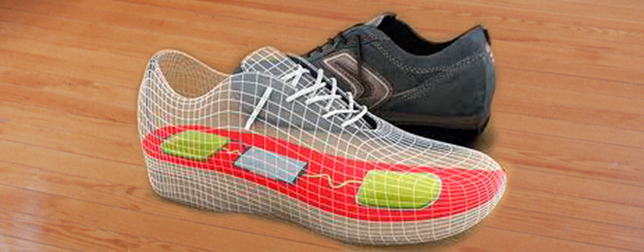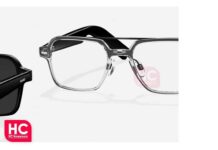Developers and researchers seem to have rediscovered the shoe as an ideal item of clothing for incorporating technology. The benefits are obvious: shoes are not washed (or at least only rarely) and there are several areas in a shoe where electronics can be introduced rather unobtrusively.
Having said that, there are inevitably some pitfalls with the shoe concept. Obviously wires cannot be used to connect the technology inside the shoe with other devices worn on the body. Furthermore, the device should ideally be controlled by a device attached to the upper body whilst the weight of the technological components must be borne at a low level. It would also be brilliant if shoe technology could be applied to different shoes rather than just one single item of footwear.
Commercially successful examples of Wearable Technologies in shoes can be seen in the form of shoe pods made by different sporting goods manufacturers. These shoe-based sensors can communicate with a sport watch or a smartphone. They were initially introduced for runners and are now also available for soccer and basketball players. Another example of shoe-based technology is heating solutions, usually in the form of insoles. Most of these solutions are very pleasant during the cold winter months even if they are rather bulky. However, these ideas do not really fit in with summer shoe trends really but we are not aware of a cooling shoe solution to date. How about you? We would be happy to learn more about it.
Furthermore we discovered several shoes with integrated GPS technology in the past. A research team at the German Aerospace Centre, for example, developed a foot-mounted sensor platform in 2010. One article focusing on this project confirms that the so-called Navishoe was inspired by the similarly named NavShoe launched by InterSense Inc. – a shoe system intended for real-time tracking of soldiers, first aiders, and workers in hazardous environments. Aetrex offers another example of a GPS shoe. Their Navistar GPS Footwear System has been developed for tracking sufferers of Alzheimer’s disease or dementia.
A fun shoe concept was developed for the lifestyle brand WeSC. According to engadget, a group of students at Sweden’s Hyper Island “digital school” developed a “social take on Nike+” and integrated an RFID chip into WeSC shoes instead of an accelerometer. The chip allows the wearer to interact with his/her surroundings and to automatically check in at a location, for instance, and share it on Facebook. Another and yet available product from the lifestyle field are Laser Laces. These are shoelaces with integrated LED technology.
A very promising shoe technology combination just recently came into our radar: ShoeSense is a project that lends a new perspective to hand gestures and wearable applications. It is a wearable system comprising a shoe-mounted depth sensor pointing upwards towards the wearer, using Microsoft Kinect. The system can interpret hand gestures and could therefore save us from pushing buttons or peering down at our touch screens in the future.
Energy harvesting with a shoe is not a new concept at all. However, it has just been rediscovered by Anthony Matua and is apparently on the verge of entering mass production. Generating energy from just walking around? “What a great idea!” although thought Christian Croft in 2007 and built a prototype called Heely’s Hack, which transforms the classic Heely’s roller sneaker into a platform for generating electricity from human motion. He was inspired amongst other things by what could well be the first project in this research field – the Parasitic Power Shoes Project, developed by a MIT research team back in 1998. A more artistic approach in this field comes from Alex Dodge. In his Generative exhibition in 2010 he explored new ways of making shoes that convert mechanical energy into stored electrical energy with the Powerstep prototype design.
The only other commercial shoe energy-harvesting project we are currently aware of comes from a company called InStep Nanopower. Their energy harvesting technology has been granted a new patent in 2011. We can’t wait to see the first products on the market.
















